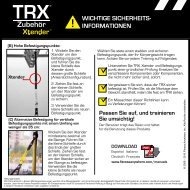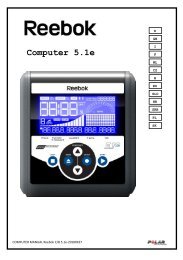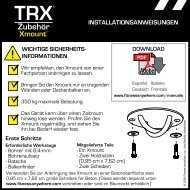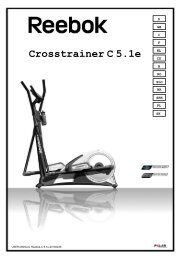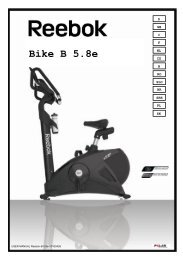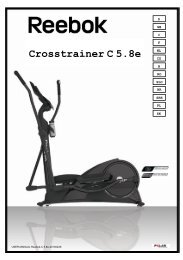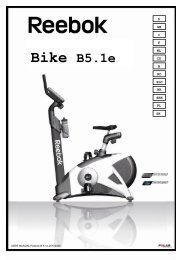by Body-Solid® - Fitness4all
by Body-Solid® - Fitness4all
by Body-Solid® - Fitness4all
Create successful ePaper yourself
Turn your PDF publications into a flip-book with our unique Google optimized e-Paper software.
EXERCISETIPS<br />
Listed below are <strong>Body</strong>-Solid’s picks of the best exercises you can do for each body part. These exercises can be<br />
done using free weights, machines and multi-station gyms. Learn to do each exercise in proper form. You can<br />
make substitutions in your training and try variations of each using different <strong>Body</strong>-Solid grips, cable attachments and<br />
accessories to slightly change the emphasis of a particular exercise. Note: Many movements, especially multijoint<br />
exercises, work more than one muscle group. For example, your front deltoids and triceps are stimulated during<br />
bench / chest pressing movements.<br />
CHEST<br />
This powerful muscle group is the<br />
cornerstone of a well-developed upper<br />
body. To most thoroughly work your<br />
pecs, include both pressing and fly<br />
movements and vary the angle of the<br />
bench from decline to flat to incline.<br />
BENCH / CHEST PRESS<br />
INCLINE PRESS<br />
DECLINE PRESS<br />
PEC FLY<br />
INCLINE FLY<br />
DECLINE FLY<br />
CABLE CROSSOVER<br />
DIPS<br />
SHOULDERS<br />
The shoulder joint, which has the<br />
greatest range of motion of all joints in<br />
the body, is best worked <strong>by</strong> training all<br />
three deltoid heads. Include a pressing<br />
movement followed <strong>by</strong> a raise for each<br />
of the three heads.<br />
SHOULDER PRESS<br />
BEHIND THE NECK PRESS<br />
FRONT DELTOID RAISE<br />
LATERAL (SIDE) DELTOID RAISE<br />
BENT-OVER LATERAL DELTOID RAISE<br />
REVERSE PEC-FLY<br />
UPPER BACK<br />
A powerful upper back is marked <strong>by</strong><br />
both middle-back thickness and width<br />
(the sought-after V-taper). This is<br />
best achieved <strong>by</strong> combining various<br />
rows with pull-downs and pull-ups.<br />
Remember to vary your grip to slightly<br />
change the stimulus.<br />
PULL UP<br />
UPRIGHT ROW<br />
LAT PULLDOWN<br />
SEATED ROW<br />
BENT OVER ROW<br />
HIGH ROW<br />
REVERSE GRIP PULLDOWN<br />
TRAPS<br />
A signature muscle of a strong upper<br />
back, well-developed traps help prevent<br />
neck injury. Shrug movements should<br />
be done with heavy weights in a straight<br />
up-and-down motion.<br />
STRAIGHT BAR SHRUG<br />
DUMBBELL SHRUG<br />
BEHIND THE BACK SHRUG<br />
UPRIGHT ROW<br />
LOWER BACK<br />
Important not only for spinal protection<br />
but also because it’s the seat of power<br />
for many exercises. If you spend a great<br />
deal of time crunching for abs, you need<br />
to balance your training for complete<br />
development and muscular balance.<br />
PULL UP<br />
UPRIGHT ROW<br />
LAT PULLDOWN<br />
SEATED ROW<br />
BENT OVER ROW<br />
HIGH ROW<br />
REVERSE GRIP PULLDOWN<br />
TRICEPS<br />
This three-headed muscle on the back<br />
of your arm is involved in extension of<br />
the elbow. Like the biceps, the triceps<br />
cross the elbow and shoulder joints.<br />
Because of this, you can and should work<br />
the triceps through a variety of angles<br />
to ensure complete development.<br />
LYING TRICEPS EXTENSION<br />
CABLE TRICEPS EXTENSION<br />
CABLE TRICEPS PRESSDOWN<br />
CLOSE-GRIP BENCH PRESS<br />
REVERSE-GRIP PRESSDOWN<br />
TRICEPS PRESS<br />
DIPS<br />
70<br />
BICEPS / FOREARMS<br />
A two-headed muscle, the biceps’<br />
primary focus is to flex your elbow and<br />
supinate your wrist. The ability to build<br />
your biceps peak is largely genetic,<br />
but exercises that maximally stress the<br />
short head will help.<br />
BICEPS<br />
STANDING BICEP CURL<br />
SEATED BICEP CURL<br />
INCLINE CURL<br />
PREACHER CURL<br />
CONCENTRATION CURL<br />
ONE-ARM CABLE CURL<br />
FOREARMS<br />
WRIST CURL<br />
REVERSE WRIST CURL<br />
ABDOMINALS<br />
The rectus abdominus has upper and<br />
lower regions, but you can’t isolate one<br />
area over the other. Still, include both<br />
upper and lower ab movement to more<br />
strongly emphasize those areas, and<br />
do twisting movements to work the<br />
obliques for complete development.<br />
UPPER AB REGION<br />
CABLE AB CRUNCH<br />
DECLINE BENCH CRUNCH<br />
LOWER AB REGION<br />
REVERSE CRUNCH<br />
HANGING KNEE RAISE<br />
HIP THRUST<br />
OBLIQUES<br />
CABLE SIDE BEND<br />
OBLIQUE CRUNCH<br />
THIGHS / GLUTES<br />
The main muscles of the thighs are the<br />
quadriceps which are composed of four<br />
muscles. You have several others near<br />
the hip joint, including the body’s largest<br />
muscle group, the gluteals. Multijoint<br />
movements (in which action occurs at<br />
both the hip and knee joints) are your<br />
best choice to work these muscles.<br />
BACK SQUAT<br />
FRONT SQUAT<br />
LEG PRESS<br />
LUNGE<br />
REVERSE LUNGE<br />
STEP-UP<br />
LEG EXTENSION (does not work glutes)<br />
HAMSTRINGS<br />
On the back of the thighs, the<br />
hamstrings balance the quads and<br />
allow for a wide range of movement.<br />
Good exercise choices include those<br />
that work the hamstrings and both the<br />
hip and knee joints.<br />
DEADLIFT<br />
STIFF-LEGGED DEADLIFT<br />
GOOD MORNING<br />
LYING LEG CURL<br />
SEATED LEG CURL<br />
ONE-LEGGED STANDING LEG CURL<br />
CALVES<br />
Calves consist of two major muscles,<br />
the gastrocnemius and soleus. The<br />
latter is best worked when the knee is<br />
flexed, as in the seated calf raise.<br />
STANDING CALF RAISE<br />
SEATED CALF RAISE<br />
DONKEY CALF RAISE<br />
LEG PRESS CALF RAISE<br />
HACK SQUAT CALF RAISE




